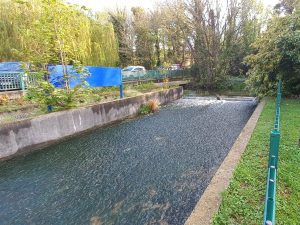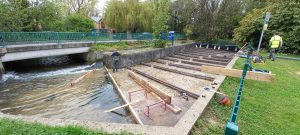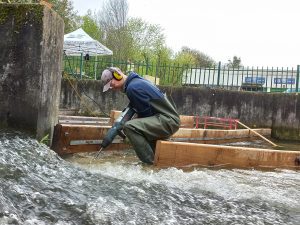The South East Rivers Trust (SERT) installed a “baffle” fish pass on the weir at the Questor industrial estate in Dartford in late April. Project officer Jack Hogan reports.
Over the past few years, we have been working to improve the lives of fish which need to move up and down the River Darent in Kent.

This began in 2021 when we completed our Acacia Hall River Restoration project in Central Park, Dartford. That project removed a large weir – a barrier to fish moving up and down the waterway – and transformed 600 metres of a silty backwater into a flowing natural river, improving both the ecology and beauty of the park.
The Acacia weir removal also opened up the way for migratory fish to undertake their journeys upstream – and salmon have already been spotted up the river beyond the project.
Our latest efforts have been at a weir a little way upstream from Central Park. Known as the “Questor weir”, it was an impassable obstacle for fish. It is long, wide, and gently sloping. This means that, for most of the time, the water that passed down it was just a skinny, shallow sheet in which no fish could have swum.
To help the fish overcome this, we designed, and have now installed, what is known as a baffle fish pass.
What are baffles and what do they do?

A baffle is defined as a device which regulates flow or passage. In this case, essentially it holds back water, becalming it and making it easier for fish to navigate. In doing so, the baffles increase the depth of water on the weir along each line of the section of river.
This results in a series of steps, or a series of rectangular ‘pools’. Breaks in the line of each baffle – known as notches – allow fish to pass between these areas of calmer water, from one ‘pool’ to another. The shapes of the baffles are also designed to reduce turbulence in the water, which helps ease the way upstream for even small fish.
Weir modifications
The concrete structure of the weir also had to be modified to allow the fish pass to function properly. At the downstream end, modifications had to be made to the bed of the weir in order for the final three rows of baffles to the installed.

At the upstream end, the crest of the weir was also notched. This was done to ensure clear passage through the old steel and concrete crest, and to ensure that enough water flows down through the fish pass. A fish pass without water would be like a ladder without rungs!
What we have installed will be used to pass both up and downstream by everything from baby eels – or elvers – to larger fish such as salmon: and the weir, or rather the newly installed baffles, can serve as their ladder to the next step up the catchment. This work builds on the eel pass that we installed on the Darent in March 2022 and we are currently looking at future projects to further improve fish passage on this river.
SERT is developing other projects on sites all along the Darent which will, step by step, restore and reconnect fragmented habitats across the whole river catchment. Some sections of the river have become “impounded”, meaning they become stand-alone water bodies that are hemmed in by man-made objects such as weirs or dams.
Our video below shows how the flow of this section of river has been dramatically transformed from a rushing, single sheet of water into one that will help the survival of migratory fish.
We would like to thank WL West Sawmill in Petworth, who hand-picked some magnificent pieces of oak from which they cut our beautiful custom baffles for the lower end of the design. The rest of the baffles, made of recycled plastic, were donated by the Environment Agency.
Special thanks must also go to Chris at JLL for facilitating the work. Without cooperation from landowners and managers we couldn’t do good work for nature such as this.
We are also very grateful to everyone at Questor – in particular, the people at Daikin and Kent Powder Coating. They offered us forklift support on demand, saving our backs, and secure overnight storage for our equipment, proving that successful river restoration work always is a collaborative effort by many different groups.
